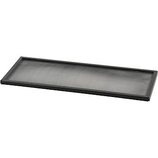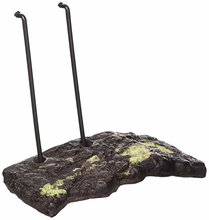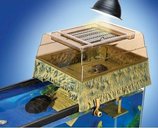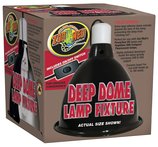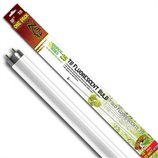Seven Things Every Good Turtle Tank Needs
Our guide to setting up your turtle's tank. Everything you need to get with our own personal recommendations.
Red-eared sliders are simple creatures with simple needs. But that doesn't mean fulfilling those needs is easy. There is a surprising amount of equipment required to keep your turtle happy. And for people with no experience setting up the habitat can be pretty overwhelming. My wife and I had some trouble figuring out the supplies we needed, so we created this site to help walk you through all the things we had trouble with.
Here's a quick overview of the supplies you need for a good aquatic turtle tank setup. Keep in mind, this is the minimum. There are other things can make your life easier that you may want to get as also, but we'll get to that later.
The 7 Items Every Good Turtle Tank Has:
- Aquarium Tank
- Water
- Submersible Water Heater
- Aquarium Filter
- Basking Platform
- Basking Heat Source
- Ultraviolet Light
Aquarium Tank
A turtle habitat can really be anything that can hold a sufficient amount of water and give enough space for the turtles to swim comfortably. That could mean anything from a small aquarium tank to a full size pond, depending on the size and quantity of turtles you have.
Most people (including myself) purchase a glass aquarium so they can keep their turtles indoors. Picking the right aquarium isn't hard, but you need to keep some guidelines in mind:
- Your turtle needs space to swim since this is its only real form of exercise
- Your turtle needs space to bask and dry off
- Your turtle is going to grow
I recommend that you buy an aquarium for a turtle larger than you have now since they will grow. The rule of thumb is that a single turtle will need between 5 and 10 times their carapace (shell) length in gallons. If you prefer metric units the number of liters should be about 7.5 to 15 times the length of the carapace in centimeters. Err on the larger side so you don't have to keep upgrading the aquarium.
For reference, adult male Red-eared Sliders grow to between 8-10 inches (20-25 cm) and females are larger at 10-13 inches (25-33 cm). That means for a fully grown one at about 12 inches you'll need a 120 gallon tank (454 liters). For young ones at 4 inches (20 cm) you can get by with a 30 gallon (113 liters). Remember, buy larger since baby turtles grow quickly!
Our Recommendations
You can buy an aquarium online if you like, but if you need to return the tank it's easier to take it to a local store than to bother with the hassle of shipping a large fragile item. Either way, here's a few amazon links to give you an idea of what you'll be looking for. A hint for those of you near a Petco, Petco will periodically have sales on aquariums where the price will be $1 per gallon. That's a fantastic price! Our local one has their sale in January. You could try asking an employee if they know if a sale is coming up.
Water & Water Conditioner
Fun fact: Turtles have no saliva and therefore must be in water to eat.
In most cases tap water is fine for a turtle. However, if you are wondering whether tap water is ideal for you check out our page about tap water vs distilled water. If you decide to use tap water (as most do), you will need to condition the water with a water conditioner:
Submersible Water Heaters
Turtles are very sensitive to temperature so you must keep their water in a specific range to keep them healthy. The most efficient way to maintain your turtle's water temperature is to use a submersible aquarium heater. When you buy one make sure you match up the heater's recommended capacity with the size of your aquarium. Water temperature should be between 75F (23.9C) and 80F (26.7C). Temperature for baby turtles ought to be kept on the warmer end of the spectrum, and older turtles should be on the cooler end. For that reason an adjustable heater is really helpful as your turtles age.
Aquarium Filter
A water filter is absolutely necessary to keep your turtle healthy. The better filter you buy the happier you will be. Don't skimp if you plan on keeping turtles! A good filter will not only pull solid waste out of the water, but will clean from the water some of the ammonia and nitrates your turtle excretes. This will keep your turtle healthy and dramatically reduce the amount of cleaning you need to do.
Quick Guidelines for Turtle Filters
- Cannister Aquarium Filters are the best
- Get a filter rated for roughly 2 to 3 times the capacity of your tank (turtles produce a lot of waste!)
- Keep some extra filter media on hand if you don't want to have to track it down
Our Recommendations
We do not recommend undergravel filters for any aquatic turtle. For more information on why check out our in depth guide on picking the best aquarium filter.
Basking Platform
Turtles are cold blooded so you'll need to provide some sort of heat source to keep them warm. Without something to keep them warm they'll become sluggish and if it gets too cold can even die. Aquatic turtles need both a water heater (above) and some form of basking heat.
Indoor sunlight is not warm enough for a turtle to bask under. A turtle needs an area heated to roughly 10 degrees (farenheit) warmer than the water temperature to properly bask. That means an air temperature between 85F (29.4C) and 90F (32.2C). Also, a turtle needs to get completely dry when basking to prevent shell rot and from growing on their carapace.
Basking Dock
The function of a dock is simply to allow a turtle to get out of the water and dry completely as they bask. Buying a dock isn't absolutely necessary, but its easier than building one yourself. A nice dock can add quite a bit to the look of a tank as well!
Basking Heat Sources
Turtles need to bask. In the wild a turtle will bask to warm themselves. Since they are cold blooded and can't warm themselves, this increases their metabolism and allows them to stay active. There are two types of products on the market that provide heat for basking. The first and most common are basking lamps and the other is heating coils. The type you choose is really up to you and how you want to setup the tank. They both get the job done. Just keep in mind if you choose a basking lamp you will still need a UV B lamp.
Ultraviolet Lamps
In the wild a turtle will receive ultraviolet light from the sun as it basks. UV light for a turtle provides the same benefit to a turtle as it does for a human. Ultraviolet light (UV B) is converted by the skin to vitamin D3, which is essential for the absorption of Calcium.
Indoor turtles don't get enough UV B light from the sun for the production of vitamin D3. Glass blocks up to 90% of UV B so even if a turtle is directly in front of a window they still won't get enough UV B. Therefore, its vital that a turtle has an artificial source of UV B light not blocked by glass or plastic. To provide this most people purchase a flourescent UV B lamp designed to be mounted over a cage.
Conclusion
If you are new to owning a turtle, make sure you check out our page on helpful equipment to make your life easier. There are many additional items that will make caring for your turtle much easier.

